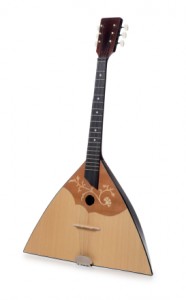The Russian Guitar (Balalaika)
Written by Vadim on November 21, 2008 – 4:56 pm -The Balalaika or Balalayka is a truly authentic Russian musical instrument and a key part of traditional Russian music. It is often heard in Russian Restaurants and at cultural events.
It is instantly recognised by its distinctive three-cornered body. Most Balalaikas have three strings, but there are also six-stringed Balalaikas. It is often referred to as a ‘Russian Guitar’, although technically it shares more similarities with the Mandolin or Banjo.
The three-stringed Balalaika is traditionally tuned to the notes E-E-A (the two lower strings have the same pitch).
The Balalaika was popular as a village instrument for centuries, particularly with the Skomorokhs – a group of people who could be best described as free-lance musical comedy performers. Their tunes often ridiculed the Tsar, the Russian Orthodox Church, and Russian society in general. For this reason, bans were imposed from time to time on the playing of Balalaika music. The first written reference to a Balalaika was on an arrest slip for two serfs in 1688, accused of being drunk and disorderly outside the Kremlin in Moscow, playing the Balalaika.
No-one is completely sure how the Balalaika got its distinctive triangular shape, but there are multiple theories to explain it:
One popular notion is that the three sides and strings of the Balalaika are supposed to represent the Holy Trinity. This explanation is not considered credible, due to the fact that musical instruments are not allowed in Russian Orthodox liturgy, and due to the church’s contempt towards the Skomorokhs.
A likelier reason is given by the writer and historian Nikolai Gogol in his unfinished novel Dead Souls (1842). He states that a Balalaika was made by peasants out of a pumpkin. If you quarter a pumpkin, you are left with a Balalaika shape.
A third theory is that just before the rule of Tsar Peter The Great (1682-1725), there had been a ban on all musical instruments. When Peter re-allowed them, only the boat builders knew how to work with wood. The Balalaika looks a little like the front of a boat, if held horizontally.
The final theory comes from a Russian tale. During the Mongol invasion of Rus (a historic slavic region that includes parts of Ukraine, Russia, Belarus, Poland and Slovakia), a Russian man from Nizhny Novgorod was captured by the Mongols, but the Mongol Khan [ruler] liked him because of his musical talent, so he released him and gave him a guitar. When the Russian man returned home, he removed three strings from the guitar, so that he would be able to repair it if he broke one of the strings, so he was left with a 3-string guitar.
Here is a video of the skilled Balalaika duo Alex Siniavski and Mikhail Smirnov, who are seen here bringing out the best sound from this instrument:
References (In Russian):
- A 1983 article by Dmitry Belinskiy from the newspaper Krymskaya Pravda
- History of Balalaika, by Georgy Nefyodov
Tags: balalaika, guitar, musical intrument
Posted in General | No Comments »




